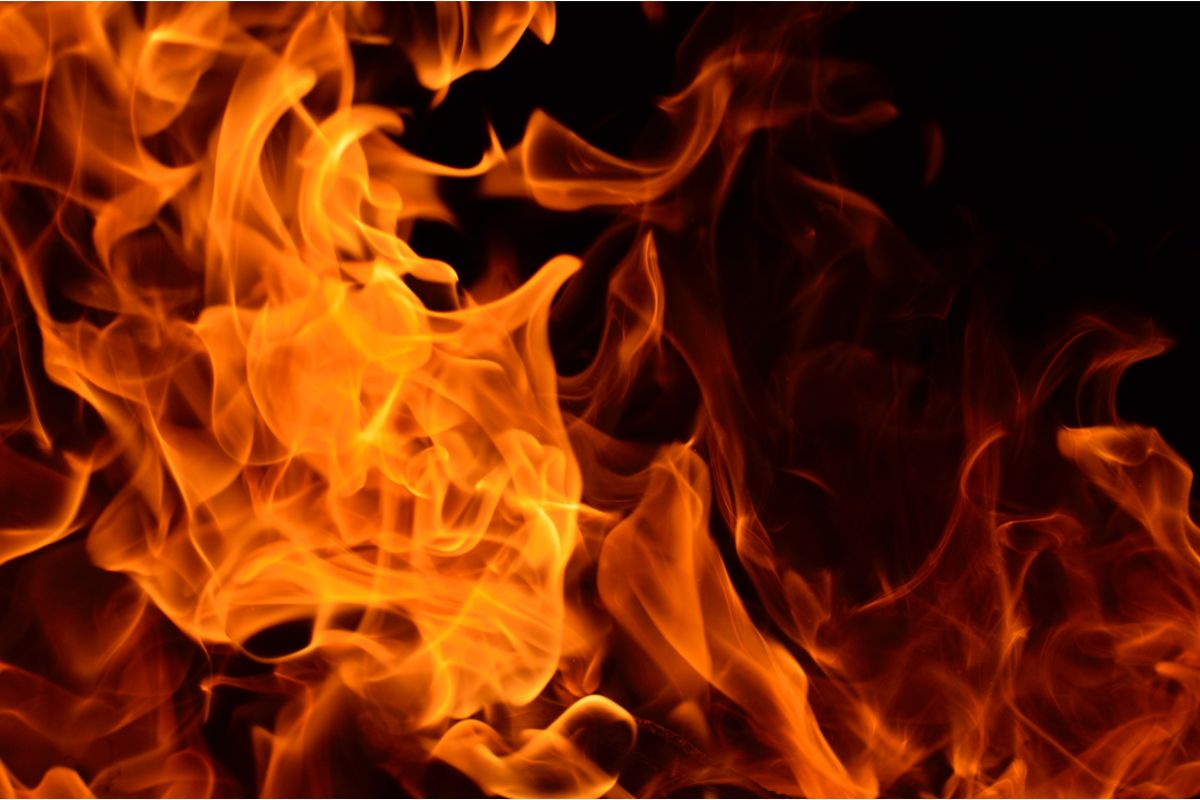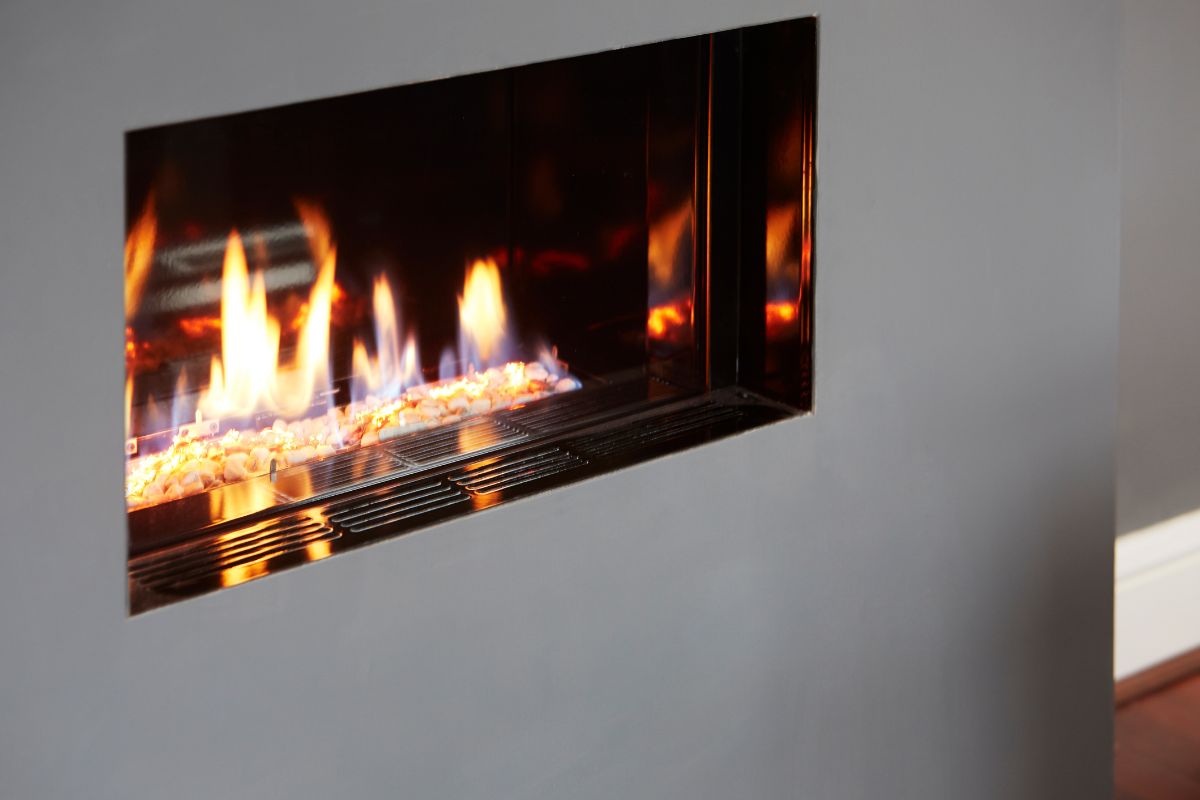There are lots of different ways that you can heat your home. Two of the most popular methods are gas fires and electric fires for communal living spaces.

But what are the main differences between them? Is one better than the other?
We have put together this informative guide to tell you everything you need to know about gas fires and electric fires. Keep reading to find out more.
At A Glance
If you want a quick answer to the gas fire vs electric fire debate, here is a round up of the key points.
Gas Fires Are
- Powerful – They tend to give off more heat than electric fires
- Aesthetic – The use of real flames makes them look great in your home
- Non-renewable – Gas is a non-renewable energy source which is not ideal for the environment
- Efficient – Gas fires are more efficient than open fires, but less efficient than electric fires
- Expensive – The purchase price and installation costs of gas fires can be expensive, along with the ongoing maintenance costs. However, gas is cheaper than electricity as a fuel source.
Electric Fires Are
- Cheap – The cost of purchasing and installing an electric fire is usually quite low
- Efficient – Electric fires are energy efficient as no heat is lost through a ventilation system
- Low maintenance – Electric fires don’t need regular inspection or maintenance like gas fires. Just keep an eye on the cord to check for scorch marks.
- Remote control – You can get remote control electric fires which are very convenient
- Flame effect – The flame effect is not as realistic but it can be used independently from the heat source for decorative purposes.
There is no definitive answer as to which one is better. It depends on what your specific needs are for your home. If you want to find out more then keep reading for an in depth comparison.
What Is A Gas Fire?
Gas fireplaces burn gas to produce a flame that radiates heat. This heat will spread throughout the room that the fireplace is in and raise the temperature.
Gas fireplaces often have a thermostat so you can set them to come on and off automatically depending on the temperature of the room.
This saves on energy and keeps your room at an ideal temperature of your choosing.
There are some gas fireplaces that are ventless and self-contained, often surrounded by glass.
Most other gas fireplaces will need a ventilation system to remove any harmful emissions and prevent them from being spread around the room.
When oxygen is burned, carbon dioxide is released. Inhaling too much carbon dioxide is very dangerous. Gas fires can also give off carbon monoxide which is also very harmful.
If you have a gas fire then you need to make sure that you maintain it properly.
A faulty gas fire can be very dangerous. If your fire has a ventilation system then it will need to be inspected periodically and any repairs carried out as soon as possible.
The vent will also need to be cleaned, as the emissions will leave deposits on the vents which can block them up and prevent them from working.
Gas fires burn clean which means they don’t emit any smoke. You don’t need to worry about the fire creating a strong smell in your home.
You still get the appearance of a traditional fireplace, but without the hassle of having to build a fire and maintain it throughout the evening.
What Are The Different Types Of Gas Fireplaces?
There are three main types of gas fireplaces:
- Vented Gas Fireplaces – these gas fireplaces have a vent attached which will lead to the outside of your house. It will channel all of the harmful emissions outside instead of into your home. It is a very safe option but the installation can be costly.
- Ventless Gas Fireplaces – As mentioned above, you can get ventless gas fireplaces. The purchase price per unit is higher but the installation cost is lower. They are designed to burn without releasing harmful emissions, so no vent is needed. This also means that no heat is lost through the vent, making them more energy efficient than vented gas fireplaces (see also ‘Modern Gas Fireplace Ideas‘).
- Gas Logs – The other type of gas fireplace is a gas logs fireplace. The gas logs last a lot longer than wooden logs, but will still need to be replaced eventually. If you want a fire that looks very realistic, then this is your best option. Gas log fires come in vented and ventless options.
Buying A Gas Fire
Here are some things that you need to consider when buying a gas fire:

- Ventilation – If you already have a chimney then you might not need to get a ventilation system installed, but you will need to get the chimney inspected. If you need to install a ventilation system then this will impact where you can position the fire in the room, there needs to be easy access to an external wall.
- Outset or Inset – Do you want your fireplace to be flush with the wall, or protruding? If you want it flush with the wall then the installation will be more complex, but will save on floor space if you have a smaller room.
- Heat output – Before you buy your gas fire you need to check what heat output you need. Measure the room you will be putting the fire in and read up on how powerful the gas fire needs to be in order to heat a room of that size.
- Glass fronted or open fronted – You can get gas fires that have a glass panel on the front, or ones that have an open front. Glass panel fires can be considered safer, but less realistic when it comes to aesthetics.
What Is An Electric Fire?
Electric fires are an alternative to gas, wood or charcoal fires. Metal elements or coils are heated up using electricity. A fan is used to push air through the coils, heating up the air and forcing it out into the room.
The hot air circulates throughout the room and increases the temperature. Like gas fires, electric fires will often have a thermostat temperature so you can decide how warm you want the room to be.
They can also be operated with a remote control which is very convenient.
Electric fires tend to be very simple to install and use. They plug into an electrical plug socket. Some of them are free standing, but others may need to be hung on the wall.
If you choose a free standing electric fire then you will be able to move it from room to room which is very convenient. You do not need a ventilation system to install an electric fire in your home.
This means that no heat is lost and the fire is efficient.
Electricity is a renewable energy source which means that electric fires are good for the environment. They release no smoke or emissions.
The only smell you might get is a dusty smell if you haven’t used your heater for a while. If dust has built up on the metal coils then it will be burned off within a few minutes and the smell will fade quickly.
Whilst electric fires are more efficient than gas fires, they don’t tend to be as powerful. It might take longer for the room to heat up.
However, the heat is more likely to circulate evenly throughout the room, getting a better distribution of warm air.
One of the great things about electric fires is that you can use the flame light effect without needing to turn on the heating element, giving you the fireplace aesthetic at any time of day and night and whatever the weather.
Buying An Electric Fire
You should think about these things before you buy an electric fire:
- Style – You can get different styles of electric fires – freestanding or stove fires, suite fires which come with a fireplace surround, and inset fires which are more flush with the wall. You can also get wall mounted electric fires, basket electric fires and radiant bar electric fires.
- Flame design – Electric fires do not have real flames. You need to choose a flame design that you are happy with. Some fires offer realistic flames, whereas others go for more modern options like color changing flames.
- Fuel bed – You can get electric fires which have a fake fuel bed such as logs, stones or charcoal.
- Heat output – As with a gas fire, you need to check what kind of heat output you need before you buy an electric fire. Measure the room and compare this to the KW power of the electric heater to make sure that it will be able to meet your needs.
- Extra features – Some electric fires come with different options and cool functions on the remote control. You get more options with an electric fire than a gas fire so make sure you are taking advantage of all of the features.
What Are The Main Differences Between Gas Fires And Electric Fires?
Here are some key differences between electric fires and gas fires that you should take into consideration.
Heat
One of the most important differences to consider between gas fires and electric fires is how much heat they give out. The whole point of installing a fire is to heat your home- but which one does it best?
Overall, gas fires tend to give off more heat than electric fires. To get an electric fire as powerful as a gas fire you would need to get a larger KW model – such as a4KW instead of 2 KW. This means that you will use more energy.
Keep in mind that gas fires and electric fires use different methods to circulate the air around the room. Electric fires use convection to spread the heat around the room.
This means that the warm air rises, then as it cools it drops back down and the air is circulated throughout the room. Gas fires use radiation heat, often amplified by the protective glass screen.
Convection and radiation are different sides of the same coin – they both spread heat throughout the room in an efficient way. You may notice a more even heat distribution with an electric fire rather than a gas fire.
Cost
Cost is another important factor when comparing electric fires and gas fires. You need to consider the cost of the unit, the cost of installation, and the ongoing running and maintenance costs.
Electric fires work out cheaper overall. The initial purchase price is lower than a gas fire. The installation is much more simple as you don’t need to install a chimney, a flue or a ventilation system.
All you need is a plug socket. Gas fires will also need to be periodically inspected, and you may need to have maintenance work carried out on the chimney, flue or ventilation system.
However, gas fires are cheaper to run and tend to last longer if they are properly maintained and looked after. If you have your gas fire for a long time then it might work out cheaper in the long run than an electric fire.
Efficiency
You can measure how efficient a fire is by figuring out how much energy it needs in order to heat a room. The efficiency of gas and electric fires will vary depending on which make and model you choose to buy.
However, electric fires are more efficient overall.
With a gas fire, some of the heat is lost through the flue and necessary ventilation which is required in order to make sure that the gas fire is safe.
The ventilation removes the harmful gasses from the room, but also allows some of the heat to escape. This does not happen with electric fires, therefore they require less energy to keep the room warm.
That being said, gas fires can still be very efficient, especially when they are correctly installed.
Environmental Impact
It is important to compare the environmental impact of gas fires and electric fires.
You need to consider whether they use a renewable fuel source, whether they release any emissions that could be harmful to the environment, and whether they waste energy.
Both gas and electric fires are more environmentally friendly than wood or charcoal fires. Electric fires use a renewable fuel source (as long as you are with a renewable energy supplier).
They also release no emissions and are very energy efficient.
Gas fires can be energy efficient. They don’t release any smoke, but they do release carbon dioxide and sometimes carbon monoxide which can be harmful in high amounts. Gas is not a renewable energy source.
Overall, electric fires are more environmentally friendly than gas fires.
Appearance
The appearance of the fire might be relevant to you if you are deciding which type of heat source to install in your home.
A lot of people feel that gas and electric fires are not as aesthetically pleasing as an open fireplace. However, they can look very good.
If you want to recreate a traditional fireplace then a gas fire will be able to replicate a woodfire more realistically. This is because of the flames it can produce.
Electric fires tend to use a flame effect, which is not as convincing. However, electric fires come in an array of modern designs which is great for homes with a more edgy or minimalistic decor style.
One thing to consider is that electric fires can be used for decoration without actually giving out any heat.
The flame effect can be switched on at any time whether or not you need to heat up the room, which can be nice for creating a cozy atmosphere without wasting energy on a warmer evening.
Which One Is Better?
There is no straightforward answer as to whether gas fires are better than electric fires or vice versa. It depends on what you need and what features are most important to you.
If you are looking for a convenient heat source then go for an electric fire. It is easy to install, easy to use and easy to maintain.
If you don’t mind the installation and maintenance required with a gas fire then it can often be a more aesthetically pleasing option as the flames are real.
If cost is a concern then an electric fire might be best. They are cheaper to buy upfront, cheaper to install, and cheaper to maintain. There won’t be any yearly maintenance fees or repairs and you won’t need to worry about cleaning the ventilation system.
However, gas tends to be a cheaper energy source than electricity, so a gas fire could be cheaper in the long term. You would need to carry out a full cost benefit analysis based on the projected prices of energy in your area.
Summary
Gas fires and electric fires are both excellent ways of heating your home. They offer different benefits so be sure to choose that one that will best meet your needs.
- Discover the Ease and Elegance of Zero-Clearance Fireplaces - July 24, 2023
- How to Build a Frame for an Electric Fireplace Insert: A Step-by-Step Guide - July 16, 2023
- Bedroom Fireplace Ideas That Will Make You Want to Snuggle Up - July 16, 2023








